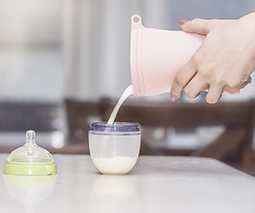7 simple ways to increase your breastmilk supply

Many mums switch from breast to bottle because they’re concerned that their baby is simply not getting enough milk. If you feel your breastmilk is dwindling, there are several ways to encourage and increase supply.
Have a chat to your GP, maternal child health nurse or lactation consultant about your concerns and check over the following guidelines for optimal supply.
1. Attach your baby to the breast correctly
Correct attachment ensures optimal feeding and milk flow, so getting this right makes all the difference. Not only does correct attachment mean that your breast will drain better, it will save wear and tear on your boobs and result in a more successful feed for your bub.
If you’re not sure whether you’re attaching your baby correctly or are having issues feeding your bub, have a chat to your maternal child health nurse, lactation consultant or trusty GP.
The sooner you get support, the better. Help truly is at hand.
2. Feed bub more often and offer frequent ‘top-ups’
Once you’ve got your attachment sorted, the next step in the direction of more bountiful supply is to feed more frequently and offer extra ‘top-ups’ between your baby’s usual feeds, or you may prefer to express and save the breastmilk for an occasional bottle feed.
“The quickest and most successful way to boost your supply is to breastfeed more often,” The Australian Breastfeeding Association confirms.
3. Look after yourself and relax during feeds
This is so much easier said than done, but it can pay huge dividends when it comes to supply – and general health and happiness too.
Relaxing and feeding your baby in a stress-free environment helps your milk to ‘let down’ more efficiently and makes the job at hand easier for everyone.
If at all possible, remove distractions, find a quiet spot and do some deep breathing or mindfulness exercise to set a relaxed tone. If you are feeling this is impossible, it’s probable that you are in need of some compassionate support.
Talk to a trusted friend or family member about the pressures you may be under, or head to your local maternal child health nurse and let them know that stress is interfering with your parenting. They can provide advice and helpful strategies.
4. Give your baby plenty of time on each breast
Slow things down. Allow plenty of time for feeding and let your baby take their time on each breast. Some babies feed slowly and steadily, spending up to twenty minutes or so on each breast.
Demand helps to fuel supply, so be mindful that while your baby might be a bit of a tortoise when it comes to feeding (slow and steady), it’s for the greater good in the long run.
5. Switch sides during feeding
If your baby is slow to feed from one side, their enthusiasm is flagging, or they seem to be drifting off to sleep, try swapping her to the other breast.
This will often prompt your baby to feed more efficiently and encourage more robust sucking and a stronger let-down reflex.
If in doubt, switch it out!
6. Massage as you feed
Massaging your breast as you feed your baby (without interrupting their important business!) can help to increase flow and thus supply.
The Australian Breasfeeding Association says:
“Stroke (the breast) towards the nipple on all sides as your baby feeds. Take care not to disturb the nipple in your baby’s mouth.”

7. Comfort feed
Frequent feeding boosts supply, so offering comfort feeds is a no-brainer way to build in extra feeds, even if they are short and sweet.
If your baby is fussy and/or you usually offer a dummy for comfort, try offering a breastfeed instead, at least while you are aiming to increase supply.
“If your baby does not settle after a feed, wait 20 or 30 minutes and then offer another quick little ‘top up’ breastfeed. Those few minutes of extra feeding and cuddling may be all that is needed to soothe and satisfy him,” the Australian Breastfeeding Association recommends.
Don’t go it alone
We can’t stress enough the importance of reaching out for support – from your maternal child health nurse or another trusted health professional – if you are having problems breastfeeding.
There really is help at hand and you don’t have to navigate this new-to-you task alone.
Three guidelines for better breastmilk supply:
- Feed more often, offering both breasts and letting baby determine feed length.
- Attach baby to breast correctly and seek support if you’re not sure of your attachment.
- Relax and allow plenty of time for feeds.
 Need some more feeding advice? Our Parent School lactation experts can help. Click to find out more or book a one-on-one session.
Need some more feeding advice? Our Parent School lactation experts can help. Click to find out more or book a one-on-one session.














